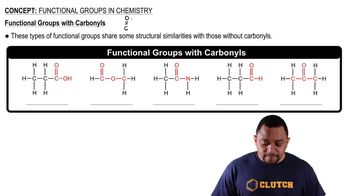Identify each organic compound as an alkane, alkene, alkyne, aromatic hydrocarbon, alcohol, ether, aldehyde, ketone, carboxylic acid, ester, or amine, and provide a name for the compound. c.
Identify each organic compound as an alkane, alkene, alkyne,
aromatic hydrocarbon, alcohol, ether, aldehyde, ketone, carboxylic acid, ester, or amine, and provide a name for the compound.
c.
 Verified step by step guidance
Verified step by step guidance
Verified Solution
Key Concepts
Functional Groups

Hydrocarbons

Nomenclature

Identify each organic compound as an alkane, alkene, alkyne, aromatic hydrocarbon, alcohol, ether, aldehyde, ketone, carboxylic acid, ester, or amine, and provide a name for the compound. e.
Identify each organic compound as an alkane, alkene, alkyne, aromatic hydrocarbon, alcohol, ether, aldehyde, ketone, carboxylic acid, ester, or amine, and provide a name for the compound. a.
Identify each organic compound as an alkane, alkene, alkyne, aromatic hydrocarbon, alcohol, ether, aldehyde, ketone, carboxylic acid, ester, or amine, and provide a name for the compound. d.
Identify each organic compound as an alkane, alkene, alkyne, aromatic hydrocarbon, alcohol, ether, aldehyde, ketone, carboxylic acid, ester, or amine, and provide a name for the compound.
f.
Name each compound. a.
